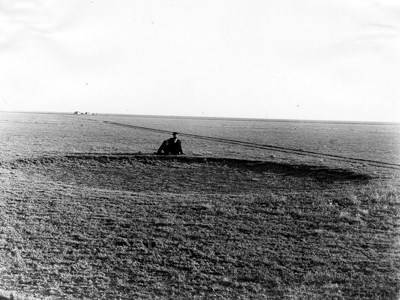Last updated: November 2, 2017
Article
Bison Bellows: What's Wallowing All About?

Photo courtesy of Willard Drake Johnson/U.S. Geological Survey.
Have you ever seen a bison in a national park rubbing against a signpost or rolling around on the ground? Bison exhibit a wide array of behaviors that may seem strange to us, but can help them prevent insect bites, advertise physical conditions, and shed their winter coats. Wallowing, or rolling in the dirt, is a common behavior that serves many functions for bison. The Merriam-Webster dictionary defines wallowing as "experiencing or enjoying something without making any effort to change your situation" or "to roll about in deep mud or water."
For bison, wallowing is when they roll on the dry ground in a "dust bath." A common explanation for the wallowing behavior relates to relieving skin irritations, whether that is from shedding a winter coat or seeking relief from biting insects. Bison will lie down and roll repeatedly onto their sides to stop insects from biting them. Rolling on the ground also creates a layer of dirt on the body that forms a defensive barrier from ticks and lice. Wallowing is also sometimes seen as a social behavior associated with play, group cohesion, and male-male conflict. During mating season, or rut, sexually mature males will urinate in the wallow before rolling on the ground to advertise their physical condition to other males. Who knew the simple act of rolling in the dirt had so many purposes for bison?
Wallowing behaviors change depending on the season, time of day, and temperature. If you have a dog, have you ever noticed how they prefer to sleep on the cool hardwood floors instead of the carpet during the summer? This is because carpets act like an insulated blanket, making your dog hotter. Therefore, they try to find the coldest places in your house, often the hardwood floor. Bison exhibit a similar behavior during summer months, because they will lie in the dirt to cool off since soil temperatures are cooler than the grass. They have little hair on their stomachs, so the soil helps cool them down during the summer months.
The wallowing behavior of bison creates actual "wallows" --- bowl-like depressions that can serve an important role in prairie ecosystems. As bison roll and lay about in wallows, they disturb and compact the soil. The disturbed soil in the wallows can provide habitat for pioneer plant species, or those that establish before other species. Wallows can serve as water reservoirs for vertebrates and invertebrates as well. These small ponds can enhance the growth of specific prairie vegetation that requires moist habitats. While the plant diversity in one wallow is often lower than the surrounding prairie, many wallows across the landscape create a mosaic of different vegetation. With bison wallows, the prairie is more biologically diverse.
